|
Ver anterior blog sobre ingresos de las universidades canadienses
Good morning. Yesterday, I took a look at some recent trends in income at Canadian universities; today I want to take a look at what is happening on the expenditures side.
Let’s start by looking at something really important, which is the difference between total expenditures and operational expenditures. In a normal year, operating budgets are 60-66% of total budgets. A little more than half of the non-operating funds go to research, and the rest is split between various things: special purpose accounts, capital, endowment, etc. Figure 1, however, shows that over the last five years, operating expenditures have been growing much faster than total expenditures. The main reason for this is that research funding has been mostly stable, while the big new source of income – international student fees – gets transferred almost directly into operational spending.
Figure 1: Real Expenditure Growth (Operating vs. Total), Canadian Universities, 2016-17
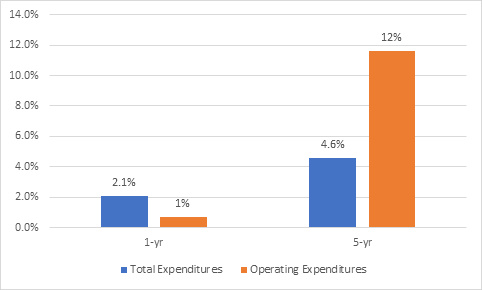
If we look at some key categories of expenditure by type, one major change of note is that aggregate salaries of non-academic staff (cryptically referred to in our national statistics as “other” salaries) are now increasing less quickly than those of tenure-track academics. Over the past five years, the increase in spending on academics and non-academics is essentially the same, though last year the increase for academics was twice that for non-academics. Growth in scholarship expenditures continues to massively outpace overall spending growth; for the first time in 2016-2017, total institutional expenditures on scholarships topped $2 billion.
Figure 2: Growth in Expenditures by Type, Selected Types, Canadian Universities, 2016-17
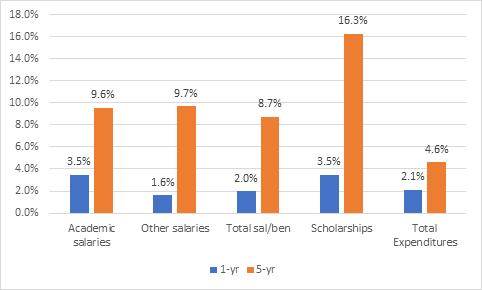
Wait a minute, though, you say. What about growth in spending on non-tenure track faculty? Everyone knows that’s ballooning because there are ever more sessionals on campus, right? Well, no. Over both the 1 year and 5-year horizons, the amount spent on sessionals is as close to flat as makes no odds. And, given the rise in spending on tenure-track academics, what this means is that the proportion of total academic wage spending going to sessionals has actually been falling for some time, as shown below in figure 3.
Figure 3: Percentage of Total Academic Wage Expenditures Given to non-Tenure Track Staff, Canada, 2000-01 to 2016-17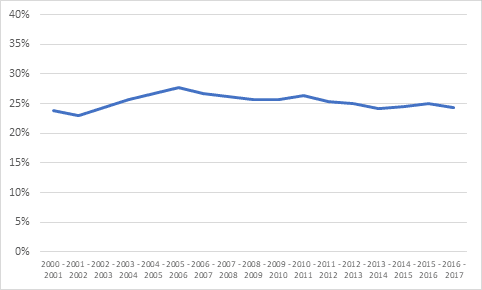
Turning to the division of operating funds by function, we find that “instructional” expenditures make up 57% of total operating spending at universities (at a high level of approximation, the definition of “instructional” spending means any spending you can apportion to a specific academic Dean or academic faculty except continuing education). The next big areas of expenditures are student services, physical plant, and administration, each of which accounts for roughly 10% of total spending. The remaining 12% or so gets spread across ICT, libraries, non-credit instruction and “external relations” (a jury-rigged concoction of communications, lobbying and fundraising).
Figure 4: Operating Expenditures by Function, in $ Millions and % of total, Canadian Universities, 2016-17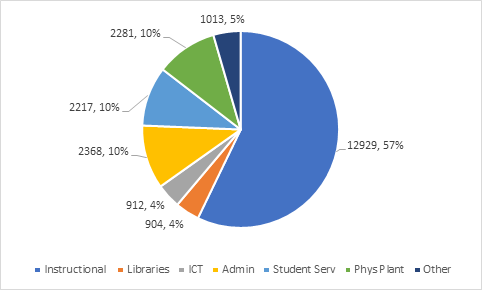
Now, what’s particularly interesting is where the growth is in all this spending. By some distance, the biggest spending increases over the past 5 years are in student services and IT (20% and 19%, respectively, in inflation-adjusted dollars). Spending on instruction – which is mostly but not entirely salaries – closely mirrors the growth in overall operating spending at 11.3% (indeed, it would be strange if it did not, given how large instruction is in the average results). But spending on admin? That terrible, awful bugaboo that is always the villain in institutional spending discussions? That trails, at just 9.4% over the last five years. Doing better, certainly, than library expenditures, but now growing less quickly than expenditures on academics.
Figure 5: Change in Real Expenditures by Function, Canadian Universities, 2011-12 to 2016-17
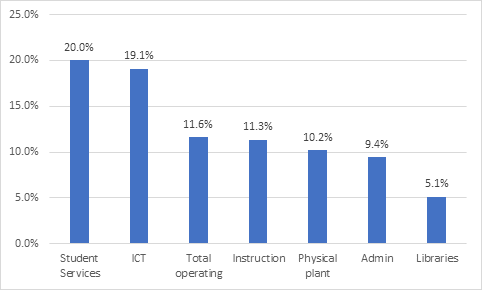
So, just to recap: i) operating expenditures are rising at inflation +2% ii) expenditures on salaries for tenure-track academics rising faster than expenditures on sessionals iii) expenditures on instruction rising faster than expenditures on administration.
Got it? Good. Let us hear no foolishness on these topics for the rest of the year.

0 Comments